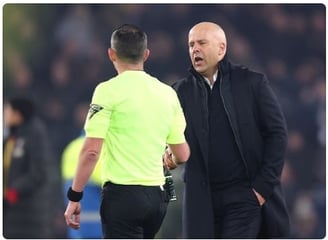Arsenal vs West Ham: Tactical Analysis & Match Review
Explore the detailed match review of Arsenal vs West Ham, featuring a tactical breakdown, key statistics, and player performances. Discover why Arsenal struggled to penetrate West Ham's defense in this Premier League clash.
2/13/20254 min read


Arsenal vs West Ham: A Tactical Breakdown and Match Review
Introduction
The highly anticipated Premier League clash between Arsenal and West Ham ended in a dramatic 1-0 victory for West Ham, with Michail Antonio scoring the decisive goal. Arsenal dominated possession and created more chances, but West Ham’s disciplined defense and counterattacking approach proved effective.
While Arsenal controlled 71% of the ball, their inefficiency in front of goal cost them valuable points. They registered 17 shots, but only 6 were on target, highlighting their lack of precision in the final third. In contrast, West Ham had just 7 shots, but 3 were on target, showing their ability to make the most of limited opportunities.
First Half: Arsenal’s Dominance but Lack of Cutting Edge
From the start, Arsenal asserted their dominance, maintaining over 70% possession in the opening 45 minutes. Martin Ødegaard was influential in midfield, linking up well with Bukayo Saka and Gabriel Martinelli on the flanks. Despite their attacking control, Arsenal struggled to break down West Ham’s low-block defensive structure.
The Gunners attempted 9 shots in the first half, but only 3 were on target, as West Ham’s compact defense blocked multiple efforts. Goalkeeper Łukasz Fabiański made 4 crucial saves, keeping Arsenal at bay. Arsenal won 5 corners in the first half, but their poor set-piece execution prevented them from capitalizing on these opportunities.
West Ham, despite seeing little of the ball, remained dangerous on the counterattack. Jarrod Bowen and Lucas Paquetá were their primary attacking outlets, looking to exploit Arsenal’s high defensive line. West Ham created only 3 chances in the first half, with one shot on target, but their ability to frustrate Arsenal was evident.
West Ham’s Tactical Discipline and Counterattacks
West Ham executed their defensive strategy brilliantly. David Moyes set his team up in a compact 3-4-2-1 formation, prioritizing defensive solidity and counterattacks.
Arsenal completed over 300 passes in the first half with an accuracy rate of 89%, but most of these were in non-threatening areas due to West Ham’s deep defensive shape.
Declan Rice, facing his former club, was a key presence in midfield, completing 95% of his passes and making 4 successful tackles in the match.
West Ham relied on counterattacks, attempting two long balls per minute in an effort to bypass Arsenal’s pressing.
West Ham’s best chance came from a set-piece situation, exposing Arsenal’s occasional lapses in defensive marking. This foreshadowed their game-winning goal in the second half.
Second Half: Decisive Moments and VAR Controversy
Arsenal continued to push forward in search of a breakthrough, but West Ham’s defensive resilience held firm. The match’s defining moment came in the 52nd minute when Michail Antonio capitalized on an Arsenal defensive error. A misplaced pass from Arsenal allowed West Ham to break quickly, and Antonio’s powerful finish gave them a 1-0 lead.
Arsenal responded aggressively, making attacking substitutions by introducing Leandro Trossard and Eddie Nketiah to add more firepower. The Gunners increased their shot count to 17 by full-time, but their inefficiency persisted.
The match saw a controversial VAR decision in the 74th minute, when Arsenal thought they had equalized. However, after a lengthy check, the goal was ruled out for offside, adding to the home side’s frustration.
West Ham, meanwhile, remained disciplined. In the closing stages:
They blocked 6 Arsenal shots, showing their commitment to defending deep.
They won 9 aerial duels, effectively neutralizing Arsenal’s crossing game.
Fabiański finished the match with 6 saves, playing a crucial role in securing the clean sheet.
Key Takeaways
1. Arsenal’s Struggles in the Final Third
Despite having 71% possession, Arsenal’s inefficiency in front of goal was a major concern. They attempted 17 shots, but only 6 hit the target, highlighting their inability to convert dominance into goals. Gabriel Jesus struggled, failing to register a single shot on target throughout the match.
2. West Ham’s Defensive Discipline
West Ham’s defensive shape was nearly impenetrable. They allowed Arsenal to complete 595 passes, but very few of them led to clear-cut chances. The Hammers made 14 fouls to disrupt Arsenal’s rhythm and were disciplined in dealing with set pieces, conceding 8 corners but allowing no goals from them.
3. Declan Rice’s Performance Against His Former Club
Rice had a strong individual performance despite Arsenal’s defeat. He had 110 touches, completed 8 progressive passes, and made 3 interceptions. However, his influence in controlling the game did not translate into a result for his new club.
Tactical Analysis
Arsenal’s Tactical Issues
They relied too much on wing play, rather than attempting through balls into central areas.
They lacked a clinical finisher—with an xG (expected goals) of 1.65, they should have scored at least once.
Their set-piece execution was poor, failing to make use of 8 corners.
West Ham’s Tactical Success
Their low block and counterattack strategy frustrated Arsenal and proved effective.
Antonio’s hold-up play created problems for Arsenal’s center-backs.
Fabiański’s saves were decisive, ensuring a clean sheet.
Final Match Statistics in Context
Arsenal had 595 completed passes, compared to West Ham’s 220.
West Ham had only 29% possession, yet still managed to win the game.
Arsenal had a significantly higher expected goals (xG) of 1.65, while West Ham had only 0.82, showing that Arsenal wasted their chances.
Despite West Ham committing 14 fouls, Arsenal failed to capitalize on the resulting free kicks.
Arsenal took 8 corners, but West Ham’s aerial strength prevented any real threats.
Conclusion
This game was a classic example of dominance without effectiveness. Arsenal controlled the game but failed to break down a well-organized West Ham defense. In contrast, West Ham executed their game plan perfectly, taking their chance when it mattered and defending with discipline.
Arsenal’s inefficiency in front of goal is a growing concern, especially as they look to challenge for the Premier League title. They must find a way to convert possession into meaningful attacking output.
For West Ham, this victory boosts their European qualification hopes, proving they can compete against top teams with well-structured defensive play and clinical counterattacks.
What’s Next?
Arsenal need a quick response in their next game to stay in the title race.
West Ham will look to build on this win and continue their strong defensive performances.
This result shakes up the Premier League standings, leaving Arsenal with questions to answer while West Ham celebrates a well-earned victory.
